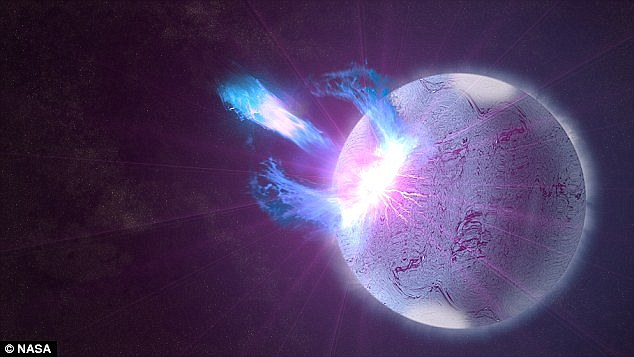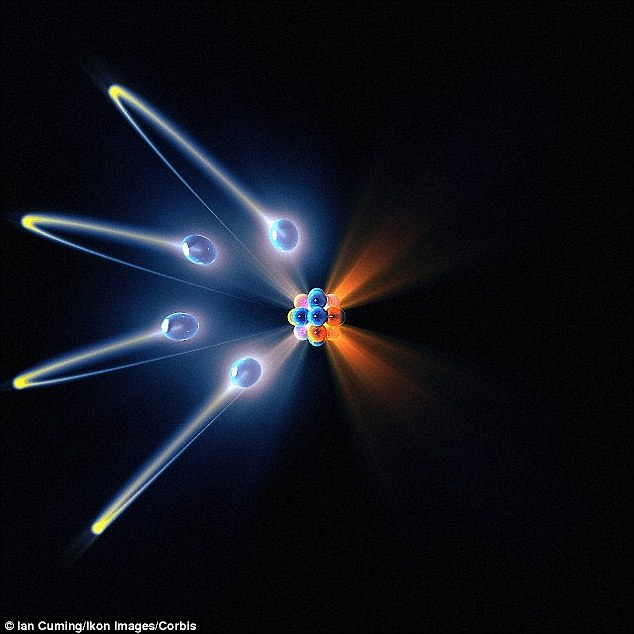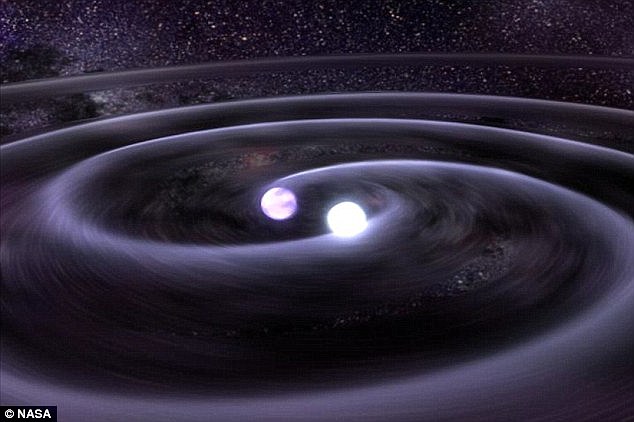![]()
![]()
Looking for the Fifth Dimension in Cygnus X-3
Is the key to finding the relatonship between mutliple dimensions and matter out there in deep space?
.jpg)
Cygnus
X-3 taken by the Chandra X-ray Observatory
A Report by Andrew Collins
Sunday, 1 July 2007
Some string theories and other quantum ideas about the nature of the universe postulate the existence of more dimensions that the three of space and one of time that are known to make up the universe. A fifth dimension or even seven separate dimensions are thought to exist, although only in a dormant, folded state - the way they emerged following the Big Bang.
Quantum scientists and particle physicists have been attempting to confirm the existence of multiple dimensions beyond our own for over 25 years, and the construction of billion-dollar particle accelerators such as the Large Hadron Collider (LHC) in Geneva, will hopefully, when its becomes operational in 2008, enable us to detect echoes of the fifth dimension.
However, now a team of Hungarian researchers feel that deep space might already provide the strongest evidence for the presence of a fifth dimension, and its suspected interaction with physical matter, with the key being extreme gravity within certain star systems.
Scientists at the Research Institute for Particle and Nuclear Physics in Budapest are focusing their attentions on a strange star system known as Cygnus X-3, composed of a collapsed compact star, thought to be a neutron star, in tight orbit with a large Wolf-Rayet type star. The former steals, or accretes, helium gas from the surface of the latter which it superheats to create a so-called accretion disc of super-hot plasma (ionized gas) around its equator. Excess matter is sporadically ejected from the compact star along its line of axis as powerful particle jets that penetrate deep space, like galactic light beams, reaching distances of up to tens of light years and destroying anything in their path.

Neutron star as a strange star (pic courtesy of NASA)
Gergely Gabor Barnaföldi, and collaborators P. Levai and B. Lukacs, the Hungarian research team involved in the work, investigated whether a state of extreme gravity exists between the two individual components of Cygnus X-3. This gravitational field is so strong that it forces an interplay between the normally inactive fifth dimension and matter contained within the core of the neutron star. This results in the production of exotic forms of sub-atomic particles known as strange quarks. These then penetrate through the surface and collide with other types of sub-atomic particles produced in normal space-time, creating ultra-high-energy cosmic particles with unique characteristics.
This extraordinary state of affairs might help explain a 25-year-old mystery of particle physics. Since 1981 particle detectors located deep underground in both the USA and Europe have detected unique cosmic particles inbound from Cygnus X-3. They come in 4.79 hour cycles, reflecting the star system's unique 4.79-hour orbital signature. This can only happen if the cosmic rays are arriving directly from source, implying that they travel the estimated 30,000 light years distance from Cygnus X-3 without either being deflected by galactic magnetic fields - a characteristic of charged particles - or decaying en route to Earth. This means that they have to be long-living neutral particles, as well as hadrons - strongly interacting particles - since they produce heavy showers of secondary particles known as muons when they hit the upper atmosphere.
When combined together, the specific characteristics of the strange particles from Cygnus X-3 become impossible to categorise. Ultra-high energy cosmic gamma rays have been proposed, although these would not produce anywhere near the amount of muon showers. Neutrinos too have been proposed. They arrive directly from their cosmic source and are also not affected by galactic magnetic fields. However, since they have virtually no mass, neutrinos very rarely interact with matter, and pass through the Earth, and us, without any kind of effect. This leaves only the neutron, a sub-atomic particle which although neutrally charged, and known to exist in compact stars, decays in a matter of minutes.
Under any normal circumstances, there is no way that neutrons might reach Earth directly from Cygnus X-3, even taking into account that as a potential cosmic particle accelerator this suspected neutron star shoots out particle debris in our direction at very close to the speed of light, meaning that any ejected particles can take advantage of Einstein's relativity law, which states that the closer something comes to the speed of light, the faster time goes by in the outside world. Such a rule implies that although any particle travelling at virtually the speed of light from Cygnus X-3 will take around 30,000 light years to reach her, from its point of view it will have existed for just a few minutes. However, this process is controversial, and is not thought to fully explain the longevity and peculiar properties of cygnets, leading scientists to speculate that they constitute the existence of some previously unknown particle.
So unique are the long-living neutral particles from Cygnus X-3 that they have been given their own name - 'cygnets', meaning particles specific to Cygnus, the constellation of the swan. Yet it is a name virtually unspeakable in particle physics, since the mere existence of such particles highlights an unsolvable controversy that over the past 25 years has become too hot to handle. So much criticism was levelled during the mid 1980s at facilities reporting the presence deep underground of cygnets that today only one - Soudon in Minnesota, USA - even bothers to report their continued presence.

Strange or quark matter particles (pic courtesy: Ian Cuming/Ikon Images/Corbis)
It has long been thought that Cygnus X-3 might well be a type a quark star or strange quark star - formed when a neutron star collapses. The problem is that when this happens the star produces so many particles known as strange quarks that it will become instable and collapse to a black hole. However, Barnafoldi and collaborators assume that extreme gravity allows the fifth dimension, normally curled up into 'rings' or folds, to come into play.
In the physical universe, the fifth dimension does not usually affect matter, but where strange quark stars are concerned, normal quarks are made to behave like strange quarks, which are forced to move more slowly through 4D space-time, since they need to curl around the folds of fifth dimensional space. This produces a certain stability within the star.
Barnaföldi et all assumed that Cygnus X-3's role as a strange quark star might help explain how cygnets are produced and why they possess such strange characteristics, for in his opinion they have quite literally been tweaked by the fifth dimension. In other words they were either forged in five dimensions, not four, or they were created by primary particles that bear fifth dimensional signatures.
As wild as these theories might seem, they were aired recently in New Scientist ('Look to quark stars for fifth dimension' NS 194:2609, 23 June 07, p. 12. Go to http://www.newscientist.com/data/pdf/press/2609/260912.pdf), while Barnaföldi's paper on the subject is published in the journal Astronomische Nachrichten in September 2007.(Preprint available at http://arxiv.org/pdf/0706.0378).
After reading this article, he informed me by email (12 July 07) that his work is based on 'strong physical assumption (e.g. static compact objects, Bohr-type quantization), which need more detailed theoretical calculations and can be veryfied by direct future experiments.' Yet he stresses that his investigations goes beyond the 'Standard Model' of the universe, of which there are, of course, different theories anyway.
Fridolin Weber, an astrophysicist at San Diego State University, California, has long postulated that Cygnus X-3 is either a quark star or strange quark star. He therefore concurs with Barnaföldi's findings: 'Cygnus X-3 is perfect for searching for extra dimensions,' he told New Scientist. 'It's basically a cosmic particle accelerator.' Yet he adds, cautiously, that more evidence is needed to confirm the nature and origin of cygnets.

A strange star orbiting a regular neutron star (pic courtesy: NASA)
CYGNUS X-3 AND THE COSMIC RAY MYSTERY - THE WIDER IMPLICATIONS
In my recent book The Cygnus Mystery and also online (see 'Cygnus X-3 and the Cosmic Ray Question' at http://www.andrewcollins.com/page/articles/thecygnusmystery_cygnusx3.htm) I cite the importance to science of Cygnus X-3, something acknowledged by Gergely Gabor Barnaföldi in his important new paper. I point out that not only are cygnet particles unique to physics, but that some of them have even managed to penetrate underground for hundreds of metres before breaking up into secondary muons, before being recorded by detectors such as Soudon in Minnesota and NUSEX in France. More significantly, cygnets are the ONLY known hadronic, or strongly interacting, cosmic particles repeatedly able to achieve such great depths, all others being stopped in the atmosphere or just beneath the surface of the planet.
In addition to this, there is now considerable evidence of a huge cosmic gamma ray excess coming from co-ordinates just 0.5 arc minutes away from Cygnus X-3. These have been monitoring since 2002 by the Tibetan Air Array, and seem to come from a spot amid a young global cluster known as Cygnus OB2. Yet no evidence has emerged from other frequencies - for instance, radio, X-ray and infrared - to indicate the presence in the vicinity of a powerful cosmic particle accelerator. This has led to speculation that the cosmic ray excess comes in fact from nearby Cygnus X-3, and is being produced by the interaction between the termination point of one of its powerful relativistic jets and the surrounding stellar medium. Add this to ultra high energy cosmic rays and gamma rays from Cygnus X-3 known to hit Earth on a regular basis, and this binary strange star system becomes the most likely source of cosmic rays hitting the earth from within the galaxy.
It is a fact confirmed by powerful evidence that Cygnus X-3 is a microblazar, the first one to be identified. This is a stellar source with one of its relativistic jets facing in our direction, like some imaginable cosmic gun barrel. It is this mechanism that Barnaföldi feels might be responsible for showering the Earth with cygnets, a bold statement which confirms exactly what I have long suspected. But just what effect might Cygnus X-3's constant barrage of cosmic particles have on Earth?
Ice core samples from Greenland and Antarctica record the amount of cosmic rays hitting the Earth. These are measured by the presence in any single year of the isotope beryllium-10, produced in the upper atmosphere through collisions between cosmic particles and atmospheric oxygen and nitrogen. Records show clearly in Palaeolithic times - for example, c. 35-40 ky and c. 17-14 ky ago - the level of cosmic rays reaching the Earth's surface was more than double what it is today. Although there is no clear indication of where these cosmic rays might have come from - since they were probably mostly charged particles, their point of origin scrambled by galactic magnetic fields - there has to be a chance that at least a percentage of them originated in Cygnus X-3, which has been in its current phase now for up to 700,000 years.
The Meinel Institute, a scientific think tank founded by Aden and Marjorie Meinel, formerly of the Jet Propulsion Laboratory (JPL), has attempted to find the point source of the Ice Age excess of cosmic rays. Their best estimations place their origin in the northern sky, somewhere in the vicinity of Draco, the celestial dragon, even though they admit to first looking in Cygnus for a possible cosmic particle accelerator and finding none - Cygnus X-3 being overlooked.
The Meinels noted a strong correlation between the periods of cosmic ray excess on Earth and great changes in human behavioural patterns, especially around 40,000-35,000 years ago, when the first cave art started to appear in Western Europe and Neaderthal man disappeared from the fossil records. They speculate, as does British anthropological writer Denis Montgomery, that cosmic rays might well have been responsible for sudden accelerations in human evolution, an opinion I voiced myself in The Cygnus Mystery. It is also one that is finding support among geneticists today. Yet the idea is by no means new. Carl Sagan as far back as 1973 wrote in The Cosmic Connection that sudden leaps in human evolution were caused by cosmic rays coming from a 'distant neutron star'. He never stated which one, although I see it as strange coincidence that it was in 1972 that Cygnus X-3 was put on the astronomical map following a spectacular display of radio frequency emissions that increased its usual output by a thousandfold. The following year intense bursts of gamma rays coming from the same source coincided with powerful X-ray and infrared emissions, revealing the neutron star's 4.79-hour orbital signature for the first time.
Not only is Cygnus X-3 likely to be the most obvious cosmic ray accelerator in the galaxy, as well as a microblazar, microquasar, quark star and even a pulsar, but there is a good chance that if cosmic rays do affect DNA and cause genetic mutations, leading to sudden leaps in human evolution, then it is also the 'neutron star' alluded to by Sagan back in 1973. If so, then the star system's relationship to Earth helps explain why Cygnus has been seen as the source of cosmic life and death since Palaeolithic times, and why it seems to be at the root of religions worldwide, from the shamanic beliefs and practices of Asia and North America to the heart of monotheistic teachings in the Middle East. This is the story told in The Cygnus Mystery.
For further information on The Cygnus Mystery click here.
For
more on starange stars and strange quark matter click here
![]()
|
Origins |
![]()